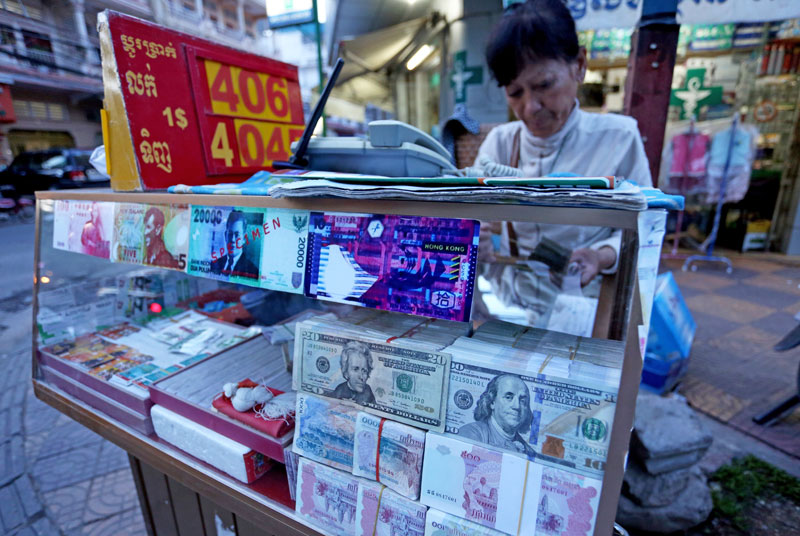Cambodia’s credit sector is expanding rapidly with the central bank saying now is the time to start infusing the market with riel and begin a process of de-dollarization in the country’s economy. But as the growth of dollarized loans outstrips those in riel, disbursing credit in the local currency will require a big rethink from both lenders, borrowers and the national bank, experts said this week.
At a conference earlier this month, the National Bank’s director of economic research said that more credit in riel would start to reduce the market’s dependence on the U.S. dollar. But the use of riel remains stagnant, and only a fraction of loans being disbursed are in the local currency.

“As with all commercial banks (certainly foreign ones) effectively all of our lending is in USD,” said Grant Knuckey, CEO of ANZ Royal bank, via email. “It is really only at the [microfinance institutions] or very small business end that you currently see KHR [riel] lending, and that segment is outside our core business.”
However, even for the few institutions that do offer loans in riel, the demand remains low.
During the first six months, local bank Acleda issued $1.5 billion in loans, an increase of 14.9 percent compared with $1.3 billion in the year before. The amount of loans disbursed in riel during that period was $84.3 million, an increase of just 5.2 percent from $79.5 million the year before.
Acleda CEO In Channy said it will take time for loans in riel to gain traction because the entire flow of production and payments must be facilitated by a confidence in the local currency that presently does not exist.
“It’s possible to release loans in riel if deposits are made in riel too. And this depends on the local production of goods for export to overseas market which makes payment in riel and brings income in riel to domestic producers,” Mr. Channy said.
Mr. Knuckey said issuing loans in riel could help encourage increased confidence, but that it was ultimately up to customers to decide whether to borrow in dollars or riel.
“In time,” he said, disbursing loans in riel, “can translate to greater acceptance of Riel for other functions of money e.g. a medium of exchange/payment. The logic is clear, but obviously there is a demand side to the equation i.e. what currency do companies want to borrow in? That is one challenge.”
Similarly for microfinance institutions (MFIs), loan disbursements in dollars are growing faster than those in riel. In the first six months of the year, total loans in dollars reached $2.3 billion, an increase of 44.7 percent compared with $1.6 billion the year before, according to recent figures from the Cambodia Microfinance Association. Loans in riel, meanwhile, increased 36 percent from the equivalent of $1.7 billion to $2.3 billion.
Even for businesspeople sold on the idea of using the riel, a row of hurdles stand in their way. Chour Chheng, the owner of Khy Siv Chheng Protein Food Enterprise, said that he tries to use riel as a point of national pride, but often has no choice but to make transactions in dollars.
“All payments and transactions with suppliers from Thailand, Vietnam, local companies are made in U.S. dollars. I use dollars because the business environment around me requires me to do so.
“I think that the loan provided by financial institution in riel is possible for just farmers but not for businesspeople.” he said, but added that “even farmers…prefer dollars.”
The International Monetary Fund (IMF) in a 2011 working paper said high dollarization leaves Cambodia susceptible to changes in U.S. monetary policy and “poses constraints on the tools available domestically with which to respond to external shocks.”
“[F]inancial sector variables (including domestic interest rates) and real economy variables (including trade) respond greatly to changes in the federal funds rate within the first few months,” the IMF said.
The report suggests Cambodia should pursue the goal of promoting the riel with market-based policies such as incentives to make the riel more convenient and cost effective.
“Policies that promote use of the riel for payments through convenient and lower-cost services than for foreign currency could be pursued,” it says.
Independent economist Srey Chanthy suggested that the National Bank of Cambodia (NBC) set up a working group to keep track of riel use by private companies.
“The central bank needs to have monetary tools to make legislation to push the use of the riel. For example the NBC should set up a working group to monitor private companies using riel in their payment transactions like hotels and phone card companies,” he said
Though de-dollarization may be a long-term goal for the central bank, economists say that there is no reason to believe that the U.S. dollar will not maintain its crucial place in Cambodia’s economy for years to come.
Jayant Menon, lead economist at the Asia Development Bank’s regional economic integration office, said despite the drawbacks with dollarization, it encourages trade through less volatility in the exchange rate.
“Exchange rate volatility that can deter trade is also less of a concern in a heavily dollarized economy.”
styllis@cambodiadaily.com; sothear@cambodiadaily.com